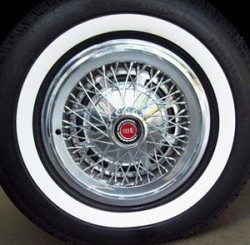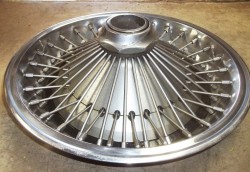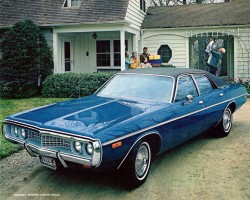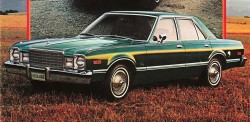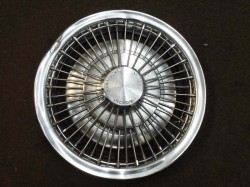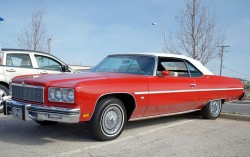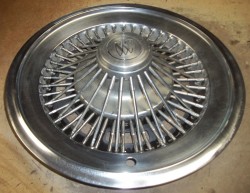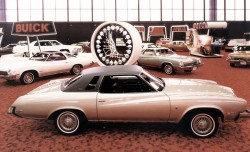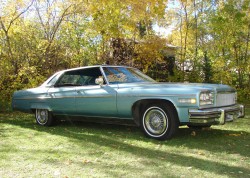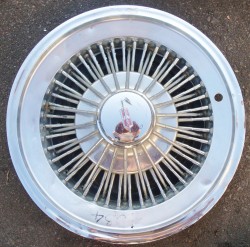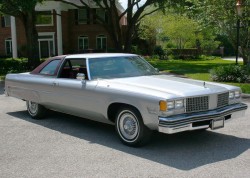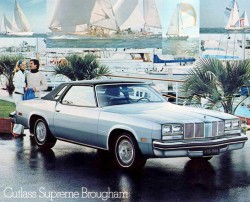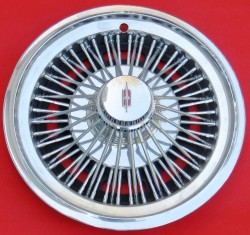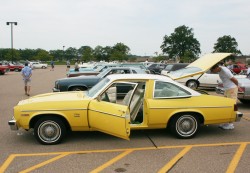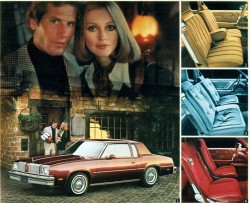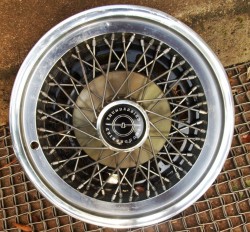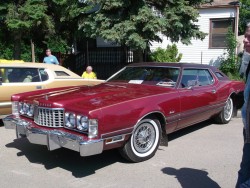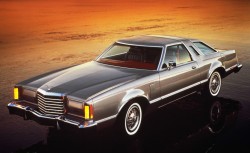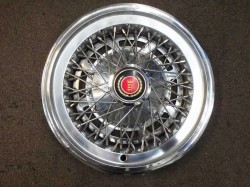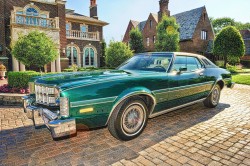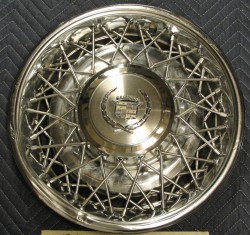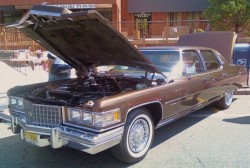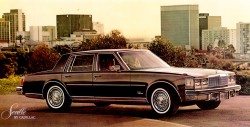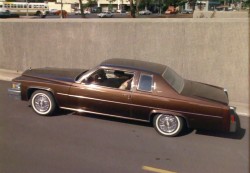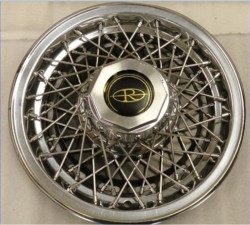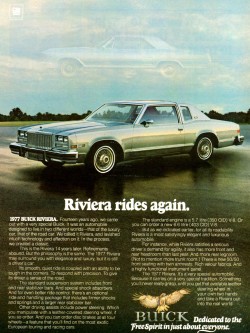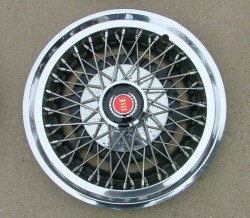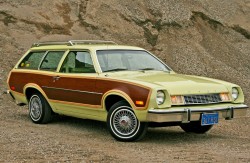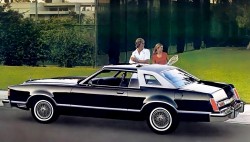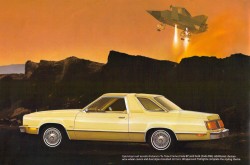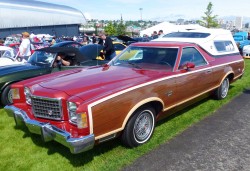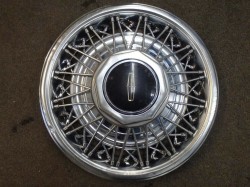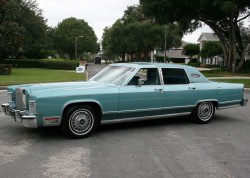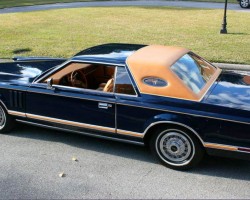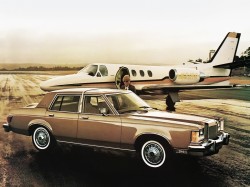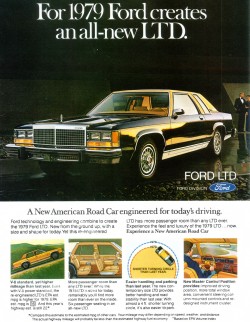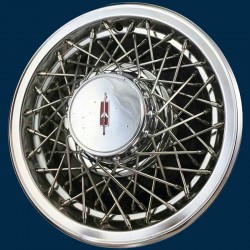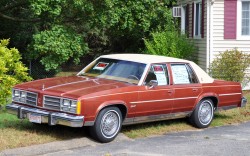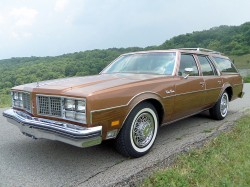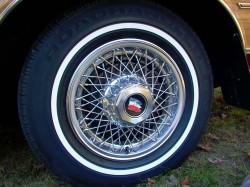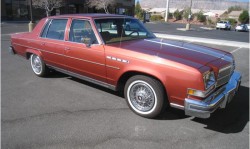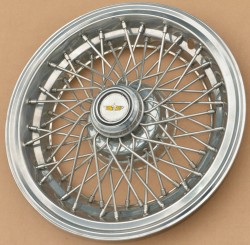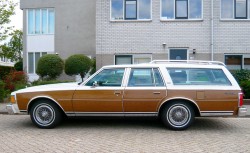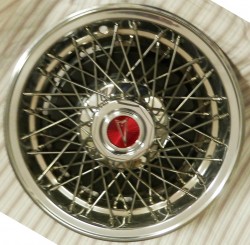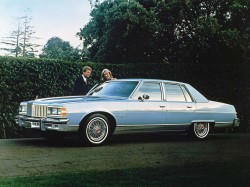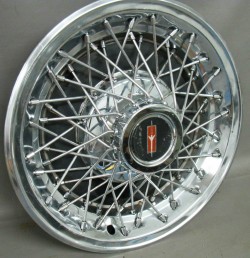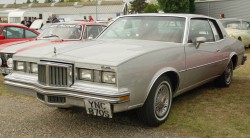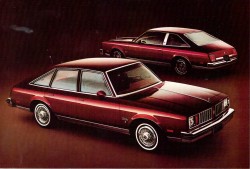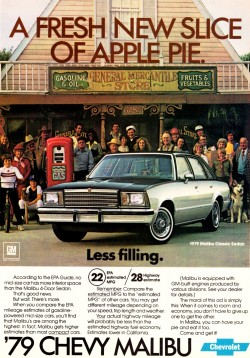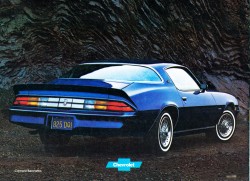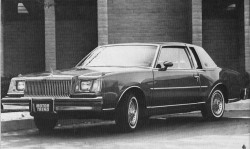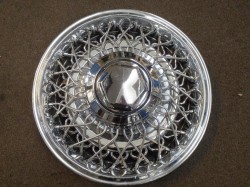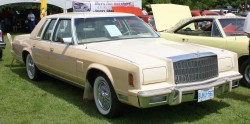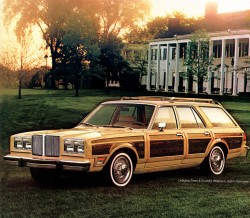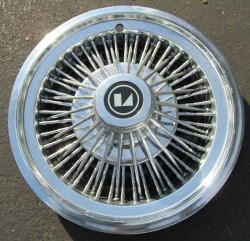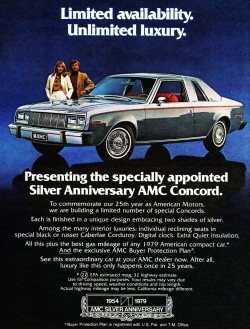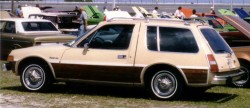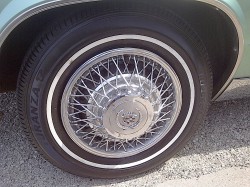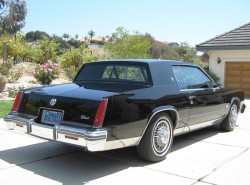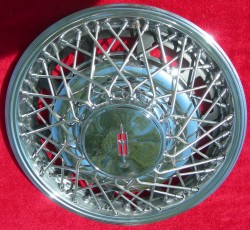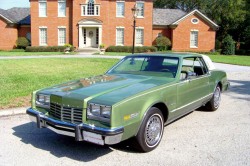(Continued from Part 2)
 The 1970s began with carryover wire wheel cover styling from the late 1960s. As that decade drew to a close, wire wheel covers were trending towards designs with two layers of straight, parallel spokes. The effect of one layer of spokes atop (yet still parallel to) another created an illusion of criss-crossing spokes when viewed from the side. This look would evolve but be maintained during the first half of the 1970s until flat wire wheel covers with criss-crossing spokes (similar to 1950s styling) would make a return.
The 1970s began with carryover wire wheel cover styling from the late 1960s. As that decade drew to a close, wire wheel covers were trending towards designs with two layers of straight, parallel spokes. The effect of one layer of spokes atop (yet still parallel to) another created an illusion of criss-crossing spokes when viewed from the side. This look would evolve but be maintained during the first half of the 1970s until flat wire wheel covers with criss-crossing spokes (similar to 1950s styling) would make a return.
The timeline below charts changes of note during the decade’s model years:
(A SLIDESHOW AND FULL-SIZE STILL PICTURES ARE BELOW AT THE BOTTOM OF THE ARTICLE)
1971:
- Chrysler introduces a new wire wheel cover that is more conical in shape (if viewed from the side) with two layers of parallel spokes. Center caps protrude farther away from the wheel, making these covers more susceptible to damage from high curbs. This wheel cover was offered on large and mid-size Dodge, Plymouth, and Chrysler models through 1978. Dodge Aspen and Plymouth Volares continued to use them through the end of their model run in 1980.
- Chevrolet also introduces a cone-shaped wire wheel cover not unlike Chrysler’s. Styled similarly to a 1967-70 design used by Chevy on full-sized Impalas, minor revisions saw two shorter spokes (instead of one) between each long spoke. These wheel covers were offered on full-size models, running unchanged through 1976.
1973
- Buick and Oldsmobile adopt the cone-shaped look, and introduce identical 15-inch wire wheel cover versions – each with brand specific center caps. Spoke patterns are similar to, yet different from, earlier 1971 Chevy wheel covers. These were available on full- and mid-size models from each division through the early part of the 1978 model year. Early promotional photos for newly-downsized ’78 Olds Cutlass Supremes feature a version of these covers modified to fit the new Cutlass’s smaller 14-inch wheels.
1974
- Ford Motor Company introduces its own cone-shaped wire wheel cover. However, unlike Chrysler and G.M. designs, spokes are not parallel but angled to criss-cross one another. These were offered on 1974-76 and 1977-79 style Thunderbirds, as well as 1975-76 Ford Elite models (Elites were luxury badged versions of the Torino coupe).
1976
- For the first time since the 1950s, Cadillac offers a wire wheel cover. Departing from 1970s trends, the new Caddy wheel cover is completely flat (not cone-shaped towards the center) and features cross-laced spokes with a larger, flat center cap. In short, very similar to the brand’s own 1950s offering. Considered very handsome, this wire wheel cover proved very popular and influenced wire wheel styling from this point forward through the end of the next decade. Available on rear-wheel-drive Seville, Fleetwood, and De Ville models, this design lasted with minimal change through the 1990s.
1977
- Ford introduces a second wire wheel cover design with criss-crossed spokes similar to its 1974 design, but flat in shape. This did not replace the earlier version, instead it was used on smaller models such as the Pinto, Mustang II, LTD II, Granada, and new-for-1978 Ford Fairmont/Futura through the end of the decade.
- Buick offers a wire wheel cover similar in style to Cadillac’s prior year offering, fitting it only on the new-for-1977 Riviera. While flat in shape rather than conical overall, the center cap (brandishing a Riviera “R” logo) was more three-dimensional than Cadillac’s was. This wheel cover ran through 1978 on the rear-wheel-drive Riviera until the model was redesigned.
1978
- Halfway through the model year, Buick begins offering the ’77 Riviera wire wheel cover on its other full-size, rear-wheel-drive Electra and LeSabre. Center caps now featured the Buick logo rather than the specific Riviera logo. Oldsmobile gets a version of this 15-inch wheel cover, and fits a perfectly round center cap to it.
- General Motors also creates another similar-looking wire wheel cover for Pontiac and Chevrolet full-size models, and new-for-1978 downsized intermediate level cars from Buick, Olds, Pontiac, and Chevrolet. This particular design was the same on all models, differing only in center cap logos and wheel size.
- Lincoln, perhaps inspired by General Motors, introduces a wire wheel cover similar in design to Buick’s – offering it on all three of its models (Mark V, Continental/Town Car, and Versailles). This flat, cross-laced wheel cover design with bigger center cap ran unchanged through 1989 on its large, rear-wheel-drive offerings.
1979
- Newly downsized, square-edged Ford LTD and Mercury Marquis models get an identical version of Lincoln’s ’78 wire wheel cover fitted with individual brand center caps.
- Chrysler does its own take on late-‘70s luxury car wire wheel covers and introduces a more modern wire wheel cover similar to Lincoln, Buick, and Oldsmobile offerings. This 15-inch wire wheel cover was offered on all Chrysler rear-wheel-drive makes and models through 1989.
- American Motors arrives late to the 1970s wire wheel cover party for ’79, introducing a cone-shaped, straight spoke cover more in line with styling earlier in the decade. This design was offered on all AMC models from 1979-80, after which it was replaced by a more up-to-date look.
Starting from the second picture below, select any of the pictures to expand them to full size. Click on the small arrows underneath the picture to scroll backward or forward.
- Chrysler used this design from 1971-1980, discarding the 1960s wire wheel cover look for a more cone-like shape. General Motors and Ford followed suit.
- A 1972 Dodge Coronet equipped with optional wire wheel covers shown in the previous picture. These were also available on Chrysler and Plymouth brand models.
- In 1979, these wire wheel covers were replaced by a more modern design on higher end Chrysler division models. For 1979-80, they remained an option on Plymouth Volares (1979 model shown) and Dodge Aspens.
- Chevrolet offered this wire wheel cover on 1971-76 full-size models. Compared with the previous design from the 1960s, these wheel covers featured two shorter spokes between each long spoke instead of just one.
- A 1975 Chevrolet Caprice convertible equipped with the 1971-76 style wire wheel covers featured in the previous picture.
- Buick introduced this wire wheel cover during the 1973 model year for its full- and mid-size models. It ran unchanged through the middle of 1978.
- A 1973 Buick Century mid-size coupe shown at that year’s Chicago Auto Show, equipped with wire wheel covers shown in the previous picture.
- A 1976 Buick Electra hardtop sedan equipped with optional wire wheel covers shown in the prior two pictures.
- The Oldsmobile rebadged version of the previously shown Buick wire wheel cover, available from 1973 until mid-1978.
- A 1976 Oldsmobile Ninety-Eight Regency coupe equipped with wire wheel covers shown in the prior picture.
- A 1976 Oldsmobile Cutlass Supreme coupe equipped with 15-inch wire wheel covers shown in the prior two photos.
- Shown here is a 14-inch wire wheel cover, designed for use on smaller Oldsmobiles through mid-1978.
- A 1976 Olds Omega with 14-inch wire wheel covers used from 1973-1978.
- A 1978 Olds Cutlass Supreme with 14-inch wire wheel covers used from 1973 to mid-1978.
- Ford offered this wire wheel cover on 1974-1979 Thunderbirds, 1974-76 Elite coupes, and 1974-78 LTDs. Center caps varied from model to model.
- A 1974 Ford Thunderbird equipped with the wire wheel covers shown in the previous photo.
- Downsized 1977-79 Ford Thunderbirds continued with the same wire wheel covers from 1974. (1977 model shown)
- The 1974-79 Ford wire wheel covers saw use on 1975 and 1976 Ford Elite models also – with a different center cap. (The Elite was an upscale spinoff of the Ford Torino).
- A 1976 Ford Elite with factory wire wheel covers.
- Introduced for the 1976 model year, these Cadillac wire wheel covers were first to return to a flat, cross-laced spoke pattern. Their look would be definitive for most wire wheel covers through the early 1990s.
- A 1976 Cadillac Fleetwood Brougham equipped with original factory wire wheel covers shown in the prior photo.
- A 1977 Cadillac Seville equipped with wire wheels shown in the prior two photos.
- Cadillac de Villes downsized for 1977 continued with the same wire wheel covers as optional equipment (1978 Coupe de Ville shown).
- 1977-78 Buick Rivieras were built off the General Motors downsized B-Body LeSabre platform, and these wire wheel covers were offered as an option.
- 1977 BUICK RIVIERA ad
- For 1977, Ford introduced this 14-inch wire wheel cover for use on midsize LTD II, Pinto, Mustang, Granada, Fairmont, and equivalent Mercury offerings.
- A 1977 Ford Pinto wagon equipped with factory optional wire wheel covers shown in the prior photo.
- This 1977 Ford LTD II coupe (sized below the standard LTD model) is equipped with the wire wheel covers shown in the prior two photos.
- This advertisement introduces the new-for-1978 Ford Fairmont Futura model, and also shows the optional wire wheel covers from the prior 3 photos.
- A 1979 Ford El Ranchero pickup model equipped with factory optional wire wheel covers shown in the prior four photos.
- Ford introduced this design of wire wheel cover for use on full-size 1978 Lincolns. It would remain unchanged through 1989.
- A 1978 Lincoln Continental sedan equipped with optional wire wheel covers shown in the prior two photos.
- This ’78 Lincoln Mark V allows a closer look at the wire wheel covers that were introduced for that model year.
- The 1977-80 Lincoln Versailles was a compact model designed to compete with the Cadillac Seville. Here, a 1979 model wears optional wire wheel covers.
- When the Ford LTD and Mercury Marquis were downsized in this form for 1979, they were offered with rebadged Lincoln wire wheel covers.
- Oldsmobile introduced this wire wheel cover design on full-size Delta 88s, 98s, and Custom Cruiser wagons midway through the 1978 model year. It would be revised for 1980 two years later.
- A 1978 Oldsmobile Delta 88 equipped with the mid-year ’78 style wire wheel covers shown in the prior photo.
- A 1979 Oldsmobile Custom Cruiser station wagon equipped with wire wheel covers shown in the prior two photos.
- During the middle of the 1978 model year, Buick offered its own version of the Olds wire wheel cover. Only the center caps differed from Olds.
- A 1978 Buick Electra equipped with wire wheel covers shown in the prior photo. These would remain unchanged on large, rear-wheel-drive Buicks through 1990.
- Chevrolet’s version of the 15-inch flat shaped wire wheel cover. This design was offered on Pontiac and Chevy full-size models as well as mid-size ones from all GM divisions except Cadillac.
- Here, a 1979 Chevrolet Caprice Estate wagon is shown with factory original 15-inch wire wheel covers that would remain unchanged through 1990.
- Pontiac’s version of the 15-inch GM wire wheel cover, used from mid-1978 through 1990.
- This factory promotional picture shows a 1979 Pontiac Bonneville Brougham equipped with optional 15-inch wire wheel covers.
- General Motors also developed this 14-inch version of the 15-inch flat wire wheel cover during the 1978 model year. They were used on intermediate-sized models by Oldsmobile (shown), Chevrolet, Buick, and Pontiac through 1988.
- Shown, a 1978 Pontiac Grand Prix with factory 14-inch wire wheel covers.
- While very early 1978 Olds Cutlass ads featured the early-70s style wire wheel cover design, later 1978 ads such as this one featured the newer style.
- This 1979 Chevrolet Malibu advertisement shows a model equipped with Chevy’s version of the 14-inch wire wheel cover shown in the prior three photos.
- Chevrolet Camaro Berlinetta models from 1979-81 focused on luxury, and were offered with a version of the 14-inch GM wire wheel covers.
- A 1979 Buick regal coupe equipped with the same 14-inch wire wheel cover design shown in the prior photos.
- To keep up with G.M. and Ford, Chrysler introduced this 15-inch wire wheel cover for 1979. It was used unchanged on rear-wheel-drive models through 1989.
- A new-for-1979 Chrysler New Yorker equipped with the wire wheel covers shown in the prior photo.
- Chrysler LeBaron models from 1979-81 such as this one were rear-wheel-drive, and offered the 15-inch Mopar wire wheel cover as optional equipment.
- American Motors was late to the wire wheel cover party, first offering these for 1979-80 across its model line.
- 1979 AMC Concord
- A 1979 AMC Pacer wagon equipped with wire wheel covers shown in the previous photo.
- When Cadillac introduced its downsized Eldorado for 1979, these wire wheel covers were created to allow for specially shaped front-wheel-drive rims.
- A 1979 Eldorado equipped with 15-inch wire wheel covers from the previous photo. Spokes protruded further out to allow for the unique wheel shape underneath.
- 1979 Oldsmobile Toronados (based on Cadillac Eldorado platforms) featured rebadged versions of wire wheel covers shown in the prior two photos.
- Shown – a 1979 Oldsmobile Toronado with 15-inch OEM wire wheel covers.

